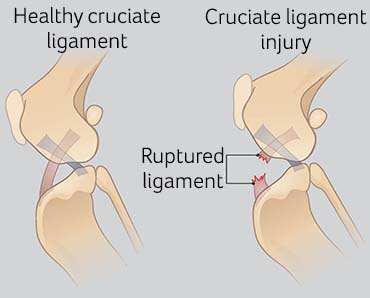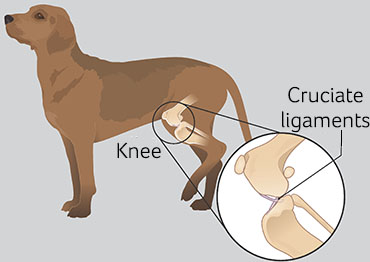Cruciate ligament damage in dogs
Overview
- The cruciate ligaments, in simple terms, are like two pieces of strong elastic that hold the knee together.
- If a cruciate ligament is damaged the knee becomes wobbly and often very painful.
- The most common way for a dog to damage a cruciate ligament is by jumping, skidding, twisting or turning awkwardly.
- Limping is often the first sign of a cruciate problem.
- Cruciate problems can be treated with or without surgery – your vet will help you decide which is best for your dog.
- Any dog can injure their cruciate ligament, but it's more common in those that are overweight or that have an inherited weakness.
- Always contact your vet if your dog is limping or if you suspect they might have injured their knee.
What is a cruciate ligament injury?
A cruciate ligament injury is damage to one (or both) of the cruciate ligaments, either a small tear or a complete rupture.
Some cruciate ligaments break after being weakened over time (like a fraying rope), and some rupture suddenly (often due to a knock or fall).

Cruciate damage is either a little tear or a compete break in the ligament Click image to enlarge.
Symptoms of cruciate damage
Cruciate ligament damage can cause symptoms that vary from a slight limp to being unable to put any weight on the leg at all. Symptoms often come on quite suddenly and include:
- Limping (mild to severe)
- Stiffness getting up and down
- Back leg pain
- Swelling in one or both knees
- Walking in an unusual way

The cruciate ligament is found in a dog's knee. Click image to enlarge.
When to contact your vet
Contact your vet if your dog is limping or you suspect they may have a cruciate ligament injury.
Treatment options
Some cruciate injuries need surgery and some can be treated without, your vet will help you decide which option is best for you and your dog.
Without surgery ('conservative treatment')
Treatment without surgery (‘conservative treatment’) relies on building extra strength around the knee to take the strain off the cruciate ligaments. This type of treatment is mostly used in dogs that weight less than 10kg and dogs with mild signs. Treatment usually includes:
- Strict rest and then a very gradual and controlled return to exercise
- Pain relief (anti-inflammatories) for the first few weeks
- Weight control
- Physiotherapy, if available
Conservative treatment often takes a few weeks to a few months but if it’s not successful or suitable, surgery may be recommended.
Surgery
There are a few different surgical options for cruciate disease. The best option will depend on your dog’s weight and size, and whether referral to a specialist surgeon is an option. Speak to your vet for more information.
After surgery, your dog will need to recover for several weeks. They will need pain relief, strict rest and a very gradual and controlled return to exercise. Your vet will give you specific instructions tailored to your dog - it’s vitally important to follow these to make sure that your dog has the best chance of recovery.
Ongoing care and outlook
With treatment and a good recovery, it’s likely that your dog will return to living a relatively normal life. However, around one third of dogs who have had a cruciate ligament injury, develop a similar problem in the other knee at some point later in their life, so it’s important to protect them from injuring themselves again by:
Sensible exercise
Once your dog has recovered, normal walking and running is fine but they should avoid very strenuous activities such as ball chasing, jumping and skidding.
Weight control
It’s important to keep your dog fit and slim to avoid putting unnecessary pressure on their joints and to slow the development of arthritis later in life.
Arthritis
Dogs who have had cruciate ligament damage nearly always develop arthritis later in life. For this reason, your vet will recommend regular check-ups and possibly joint supplements.
Preventing cruciate disease
The two best things you can do to prevent cruciate problems in your dog is to:
- Keep them slim - overweight dogs are much more likely to develop a cruciate ligament injury because of the extra strain on their joints.
- Give them sensible exercise - keep your dog fit, build their fitness up gradually, never push them hard to do more than they are used to. Unless your dog is very fit, limit strenuous exercise such as jumping, skidding and chasing.
Which breeds are at risk of cruciate disease?
Cruciate injuries can develop in any dog, but there are certain breeds (such as the Labrador, Rottweiler and Newfoundland) that are slightly more at risk. However, dogs most at risk of an injury are those that are overweight, and those that tear around on uneven ground, chasing, turning quickly, skidding and jumping.
Cost
Treatment for a cruciate injury can cost a lot of money. It’s impossible to give exact pricings because each vet clinic varies and cost depends on the size of the dog and treatment needed.
Always speak to your vet if you can’t afford the treatment they have recommended, there might be other options.
Consider taking out dog insurance as soon as you bring your dog home, before any signs of illness start. This will give you peace of mind that you have some financial support if they ever become unwell.
Published: June 2020
Did you find this page useful?
Tell us more
Please note, our vets and nurses are unable to respond to questions via this form. If you are concerned about your pet’s health, please contact your vet directly.
Thank you for your feedback
Want to hear more about PDSA and get pet care tips from our vet experts?
Sign up to our e-newsletter
Written by vets and vet nurses. This advice is for UK pets only. Illustrations by Samantha Elmhurst.

